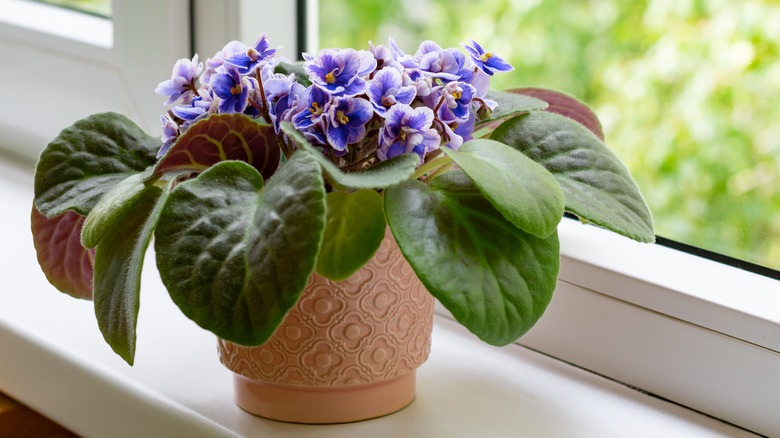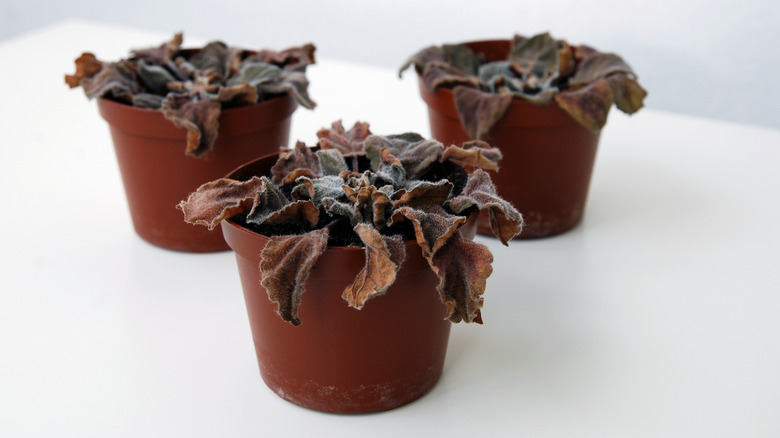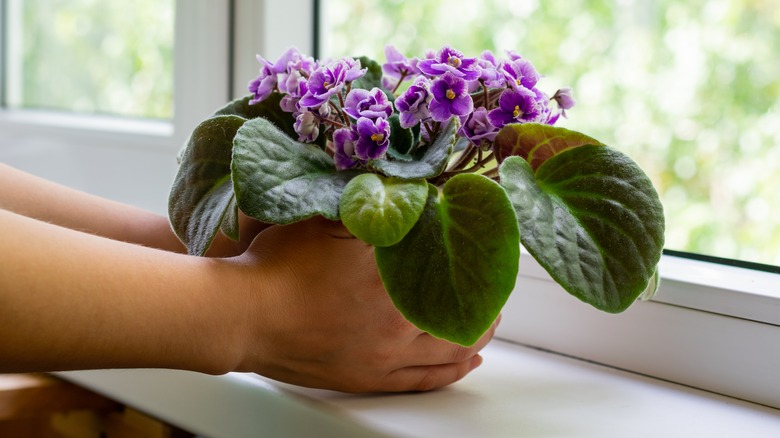Avoid Making These Crucial Mistakes With Your African Violet Houseplants
The beautifully colorful fringed or ruffled flowers and quilt-like feel of the leaves of the African violet (Saintpaulia ionantha) make it an excellent choice for many windowsills. These plants are available in a variety of colors, sizes, and types, but all tend to be quite lovely. With their almost velvet-like leaves, they add texture and vibrance to any houseplant collection. While not necessarily hard to grow, African violets need a bit of help to thrive.
Common mistakes — including how the plant is watered and not providing the right amount of light — will impact the plant's growth and ability to bloom. They are somewhat sensitive to factors like temperature changes, too. If you don't pay attention to changing seasons and the amount of direct sunlight, the plant could struggle to survive.
Keep an eye out for some of the most common problems that affect African violet houseplants. For example, if you've noticed a drop in the flowers produced or there's debris or a dust-like material on the leaves. Discoloration of the plant's leaves and wilting are also common signs that the plant isn't getting the care it needs. With a few changes and more time spent on plant care, it's possible to improve the health of these plants and see bigger blooms, robust leaves, and a nice little pop of color on your windowsill again. Successfully growing African violets takes understanding the unique needs of this sweet little plant.
The most common mistakes in watering your African violet
African violets are rather picky about how they are watered. A common mistake owners of this houseplant make is improperly watering them — including getting their leaves wet or using too cold water. Overwatering or underwatering is a common reason why these plants don't bloom. Overwatering can lead to the development of root rot, which will damage the plant and make it much harder for it to thrive.
Moisture is important to these plants, and while environmental conditions, as well as the size and specific variety of the plant matter, it's a good idea to create a watering routine. Establish the plant in a container with drainage holes in the bottom. When watering this plant, make sure the water is 60 degrees Fahrenheit or above, as water that's under 55 degrees Fahrenheit will cause ring spots, a condition that leads to light green coloring of the leaves.
Then, make sure you water in the right method. Start with watering from the ground up, which means adding water to the container under the plant and allowing the soil to absorb it. This method helps to protect leaves from damage that's caused by water getting on them. Every few times, water from the top down to aid in the removal of excess salts in the soil. Just be sure to avoid getting water on the leaves as much as possible.
Tackle these mistakes next
Don't make the mistake of leaving this plant to fend for itself. It needs routine maintenance, including the removal of dead leaves and flowers from the soil to help keep the plant clean.
You need to be sure the plant receives the correct amount of sunlight. Too much is not a good thing, but neither is too little. You'll know your plant isn't getting enough light if you notice fewer flowers. It may be getting too much direct sunlight if the plant's leaves are pale. While African violets need light, it doesn't necessarily need to be direct sunlight. These are shade-loving plants for the most part and do best in indirect light. Too much bright light will scorch the leaves, creating dark discoloration. Sometimes, too much light can also cause African violet leaves to curl.
Monitor the temperature in the space. African violets benefit from warmer temperatures between 70 and 90 degrees Fahrenheit during the day and as low as 60 degrees Fahrenheit at night. Because of how sensitive this plant can be to temperature changes, aim for more level control of the air temperature. If it's too cold, the leaves will shatter and dry out. Take a moment to rotate the plant every few days to ensure it's getting even access to temperature and sunlight for the best overall results. Keep drafts at bay when possible, especially when temperatures get colder outside.


